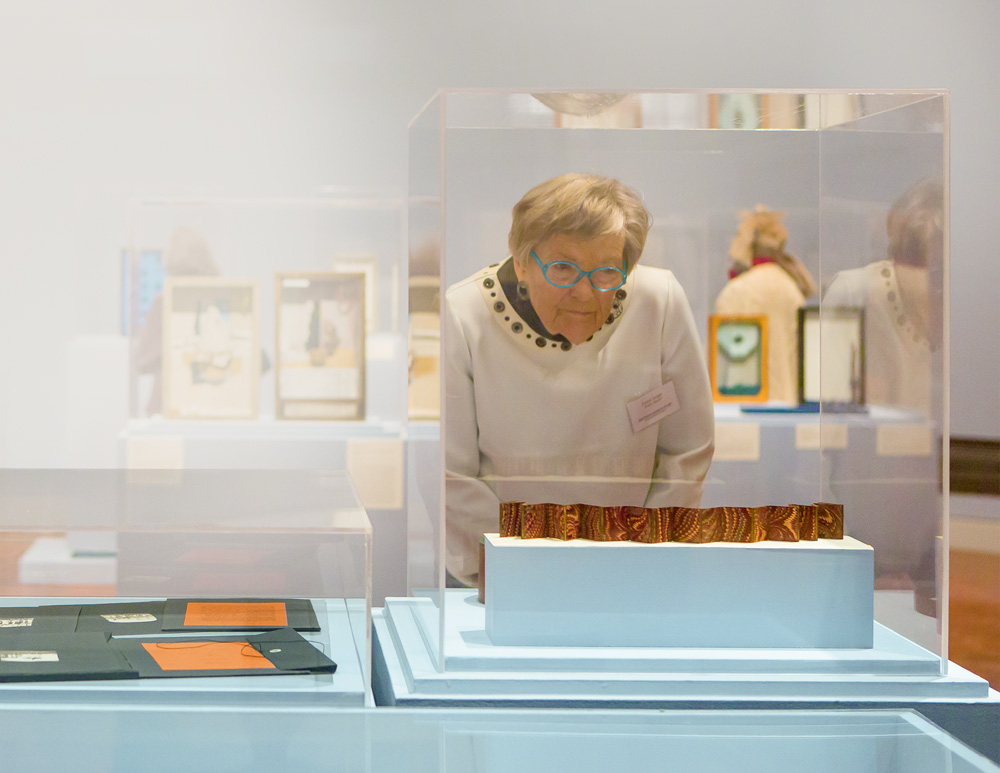

Art Is Her Mission
Carol Angle, M.D., has always made it her mission to solve difficult problems. She spent 45 years at the University of Nebraska Medical Center as a pediatrician, nephrologist, and toxicologist. Over the course of her distinguished career, Angle became known as one of the nation’s leading experts on lead poisoning.
Now retired and living full time in Charlottesville, she is still committed to helping others. This self-described “museum hound” and longtime patron of The Fralin Museum of Art has turned her attention from science and medicine to the art world.
Angle’s fascination with art was born of necessity. “I am profoundly deaf. I have been since the age of 25,” she said. “Because of that, I have always been interested in the visual arts.”
Last year, her interest translated into action when she created the $1 million Angle Exhibition Fund at The Fralin. Her gift is the first endowed fund to support art exhibitions at the museum.
According to The Fralin’s director and chief curator, Matthew McLendon, Angle’s gift fills a pressing need at the museum, which is home to 14,000 pieces of art. “Exhibitions are one of the museum’s costliest programs and are logistically challenging, so this is an important gift for a fundamental part of the day-to-day operations,” he said. “Carol’s endowment is based on a deep understanding of what we do here.”Prior to assuming his role at The Fralin in January, McLendon spent six years as the curator of modern and contemporary art at The John and Mable Ringling Museum of Art in Sarasota, Florida. The Ringling is affiliated with Florida State University, and McLendon is interested in the unique position of university museums.
“The museum, particularly the university museum, can be a nexus of exchange and dialogue, bringing together multiple disciplines,” he said.
Angle’s generous endowment will benefit UVA students, as well as K-12 students throughout the Central Virginia region. “Our core mission has always been to serve UVA faculty, students, and the greater Charlottesville community through engaging exhibitions and programs,” McLendon said. “With this endowment, we are even more capable of doing just that.”
Currently, the Angle Exhibition Fund is supporting “Dealer’s Choice: The Samuel Kootz Gallery 1945-1966,” which runs through mid-December. It is the first exhibition that examines the critical role that New York gallery owner Kootz (Col ’21) played in establishing modern American art as an international force. Kootz made a major gift of paintings to The Fralin in 1976-77.


Angle has supported The Fralin and its directors over the years—she reserves particularly high praise for McLendon—and she has always come away impressed by how the museum has been able to do a great deal with limited resources. With the Angle Exhibition Fund, those resources have received a much-need shot in the arm.“After I became aware of how little financial support they had for their exhibitions program, I wanted to do something positive for the museum,” she said. “This seemed like the best way.”
For more information about The Fralin Museum of Art, visit uvafralinartmuseum.virginia.edu.
A Conversation With Matthew McLendon
Prior to joining The Ringling, McLendon was the curator of academic initiatives at the Cornell Fine Arts Museum at Rollins College; he arrived there after having worked at Tate Britain, in London.
- Describe how this endowment will benefit the museum and the UVA community.
As a teaching museum, The Fralin serves more over 1,800 UVA students each year, and exhibitions are the focal point around which much of our programming is built. Carol’s gift directly supports broad-based student engagement and intellectual expansion by providing financial stability for the exhibitions program and enabling us to be more ambitious in our concepts. - How will the endowment help the broader Charlottesville community?
One example is Writer’s Eye, now in its 31st year. While open to all ages, it serves more than 4,000 K-12 students who tour our exhibitions and then engage in creative writing exercises, based on key works of art. We now have parents who were Writer’s Eye participants and whose children are a part of the program. This sustained community engagement is a real strength of museums. - What are the museum’s philanthropic needs?
I’m in the early days of understanding the complexities of The Fralin, but I would like for us to endow our key staff positions. We currently serve more than 30,000 visitors, but I know that number can grow with additional staff. We are also at physical capacity in our current space. Heading into the University’s bicentennial, I want to make sure The Fralin is at the heart of the future vision of UVA, as a dynamic space where students, faculty, and the larger community come together. To achieve this, we must think about physical expansion. - What do you see as the museum’s future in 5 years?
I’d like to see us well down the road to an expanded program in an expanded space. I want The Fralin to be the ‘go-to’ place for UVA and the wider community when they want a deeply meaningful, enjoyable engagement with the past and present, mediated through art.

